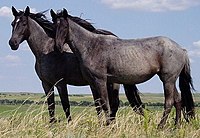
Photo from wikipedia
Abstract This article presents an overview of the literature on aging in the context of human–horse similarities and describes the role of animal models in the study of human geriatrics.… Click to show full abstract
Abstract This article presents an overview of the literature on aging in the context of human–horse similarities and describes the role of animal models in the study of human geriatrics. For any given comparative aging study, the choice of a specific animal species is based on the physiological and pathophysiological resemblance of the aging process in animals and humans. In horses, the physique of the body, the course of the aging process, and the spectrum of naturally occurring diseases are similar to those in humans. Although the horse is not a laboratory animal, aging horses are a relatively numerous, which allows for geriatric studies on diseases with a similar course as in humans, for example, diabetes or polysaccharide storage myopathy. The potential benefits are two-pronged as some of the developments in human medicine can also be implemented in equine therapy. Moreover, aged horses can be used in hippotherapy for elderly people. In the near future, horses may be able to help extend the human lifespan or at least diminish the consequences of aging.
Journal Title: Journal of Equine Veterinary Science
Year Published: 2019
Link to full text (if available)
Share on Social Media: Sign Up to like & get
recommendations!